The EOS System 30th Anniversary InterviewsDevelopers Look Back on the History of the EOS System – Part 1
The EOS system boasts the world’s largest share* in the digital interchangeable lens camera market. Its development, which involved the replacement of the traditional FD mount with the fully-electronic EF mount, can be described as a historic project; what resulted from it were designs for EOS cameras and EF lenses that were decades ahead of their time. Six developers (lens developers: Shingo Hayakawa, Seiichi Kashiwaba, Junichi Murakami; camera developers: Yasuhiko Shiomi, Yasuo Suda, Shoji Kaihara) have been involved in the development of the EOS system since it began in the early 1980s. In the following discussion, the team looks back on the three challenging decades that they’ve been through.
* As of March 29, 2017, based on a Canon survey
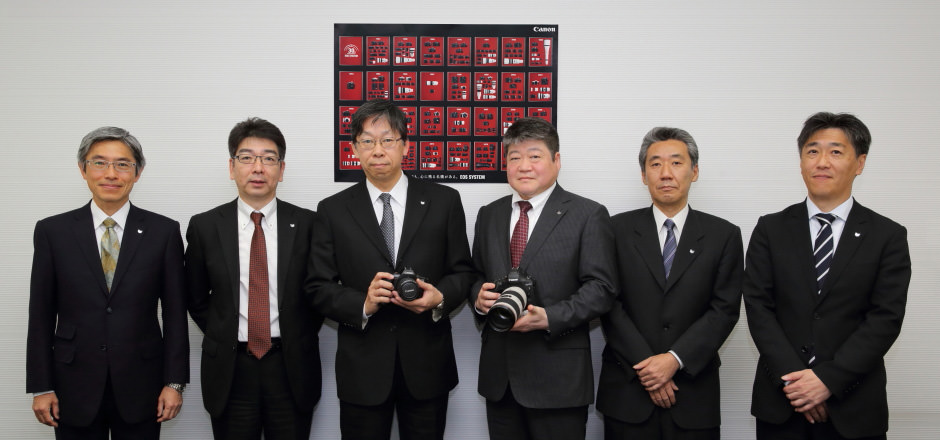
Left to right: Yasuo Suda (autofocus), Shoji Kaihara (mechanical) Yasuhiko Shiomi (system), Shingo Hayakawa (optics), Seiichi Kashiwaba (mechanical), Junichi Murakami (electrical)
On March 31, 1985, Canon made the decision to develop a camera system that would become the foundation of its key strategy for autofocus (AF) SLR cameras. At the decision-making meeting, leaders and engineers of Canon’s marketing subsidiaries and affiliates from around the world gathered to discuss the development of the system. It took only two years to accomplish this major development project, which was dubbed the “Entirely Organic System*”.
* Later renamed the “Electro Optical System”.
The EOS 650, the very first EOS SLR camera, was launched two years later on March 1, 1987, which also marked the 50th anniversary of Canon’s founding. The camera featured the newly-developed EF mount. The name “EF”, which stands for electro focus, emphasises the adoption of a fully-electronic focusing technology. The introduction of a new mount is comparable to starting a new company and making a camera from scratch—a big gamble indeed.

EOS 650 (Released in 1987)
The EOS 650 was the first camera in the EOS series, which featured a fully-electronic EF mount in the place of the conventional FD mount used on Canon cameras.
The path to the introduction of a fully-electronic mount
—Looking back, the adoption of a fully-electronic mount seems like a natural consequence, but it must have been a major change back then. What led to this decision?
Suda Before the EOS series was launched, our cameras featured the FD lens mount. However, a fully-electronic mount was essential in order to achieve a high level of AF technology with our wide variety of interchangeable lenses. To realize a high-precision AF that moves the focusing lens elements optimally according to the focusing distance or zoom position, it was a must for the lens to exchange information with the camera as well as to eliminate any mechanical error. This is why we chose to control the camera system by linking the camera with the lens via electrical communication. Through this, we were able to achieve high-speed and high-precision AF even at such super telephoto focal lengths as 600mm. What’s more the aperture was also electrically linked to enable smooth video shooting and playback, a feature that is taken for granted on cameras today.
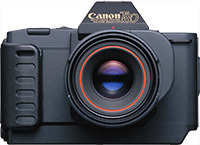
T80 (Released in 1985)
Canon’s first AF 35mm-format SLR camera. It employed an FD mount, as well as a mechanism for transmitting electronic signals.
I believe the idea of a fully-electronic mount is largely attributable to the experience we gained from developing the T80, an AF camera that used lenses with built-in motors. In the case of telephoto lenses, having the motor inside the camera made it difficult to achieve high-speed focusing. Coordinating the aperture drive was also a test of limits due to the complex mechanisms of both the camera and the lens. However, we persevered because we felt that the future of next-generation cameras hinged on the development of a new, fully-electronic mount. Even still, there was talk at the time of developing the new mount as an extension of the FD mount.
Shiomi Back then, the growth of electronic technology was in full swing, with microcomputers being introduced in a wide range of products. While we felt that mechanical structure was also important, we anticipated growth in semiconductor technology, including that of computers, and ultimately decided to develop a fully-electronic mount with our sights set on the distant future.
In light of our longstanding rivalry with other players in the industry, whenever we try to pre-empt the next basis for competition, we try to think of such scenarios as what would happen in five years’ time or what would be the core technology in 10 years, and so on. So far, we have been able to make accurate predictions, including the introduction of a new mount and the electronic technology.
Suda I have with me here a camera that Canon developed 30 years ago, to which I’ve mounted one of our latest lenses. This camera, the EOS 650, is able to function without any problems. That’s because we designed it with the ability to allow for expandability in communication. The EF70-300mm f/4-5.6 IS II USM lens, which was released in 2016, features a “Nano USM” miniature motor that was newly developed for the AF drive system. There’s also an LCD screen that displays information related to shooting, such as the focusing distance, focal length and the amount of shake in the camera and the lens. Of course, the lens also features image stabilization (IS). All of the ideas from the initial phase of development have been incorporated into this lens, and it’s still able to function with the EOS 650. The EOS system is a profound system indeed.
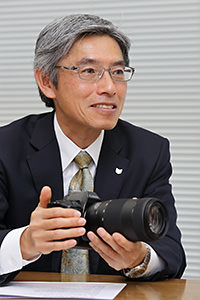
The first-generation EOS 650 allows for expandability in communication and can be used with the latest lenses. (Suda)
—The circumstances surrounding electric power must have changed substantially since then.
Shiomi During the early years, power capacity was limited. There was a rule called the “Power Constitution” that determined how power supply was to be distributed between the camera and the lens. Of course, the philosophy of preserving the framework of the Power Constitution has been handed down and still exists today.
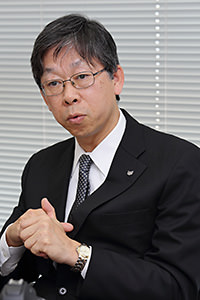
The concept of the Power Constitution still exists today. (Shiomi)
Looking at the evolution of the EOS over the years, we can see that the main uses of electric power have changed considerably. In the early days, film cameras simply needed to achieve a certain level of high speed continuous shooting performance. So, what we did was ensure there was sufficient power for feeding the film in the camera, followed by supplying power to the lens within a certain timing so as to enable high-speed tracking by Servo AF. Thus, chronological sequence determined the details of how much electric power was used by the camera and the lens.
With the amount of power consumed by both the camera and the lens growing larger over time, we tried to come up with an optimal camera and lens design that allowed total power consumption to remain as constant as possible.
Murakami This change has enabled us to increase the focusing and aperture adjustment speed of the lens, while at the same time enhancing the IS feature. So, we can say that the basis of our development of the mount are also the basis for enhancing features such as AF, AE and IS.
Reason for moving away from the FD mount
—What is the biggest reason for giving up the FD mount?
Hayakawa The development department always strives to stay ahead of the curve while paying attention to current technological trends. Even back then, we were aware of the need to incorporate new systems in order for the AF system of SLR cameras to be closer to the ideal form.
With the EOS system, we aim to achieve “speed” and “comfort,” which are reflected in the Three Principles of EOS Development*. Canon’s T-series models, which employed an FD mount, already enabled communication between the camera and the lens, with the mechanical components working in tandem. Yet, in order for the AF feature to realize its ideal form, it was necessary to enable expandability of such aspects as communication. To achieve this, we arrived at the decision to adopt a fully-electronic mount. We also needed to enhance communication between the camera and the lens so that we could address the various technological advancements in cameras and lenses, including the AF feature. In other words, we were trying to achieve a complete division of labor between the camera and the lens.

A new mount was necessary to expand the camera system. (Hayakawa)
Shiomi We still practice the division of labor between the camera and the lens. Even today, you would be hard-pressed to find consumer products that fulfil a single function by combining multiple product families. Even back then, Canon did not consider the lens a mere camera accessory. Rather, we viewed it as a main product on its own, and this view remains unchanged. As one vast, interchangeable system of products, the EOS cameras and EF lenses have been in the market for more than three decades, and their lineups have continued to expand during that time. This, I believe, is a very rare accomplishment.
* The Three Principles of EOS Development
1. There must not be a significant markup in price compared to existing camera models as a result of renewing the AF system.
2. AF tracking must be possible during handheld shooting of indoor events using the 300mm f/2.8 lens.
3. The level of AF sensitivity must be equivalent to the brightness level of the metering sensitivity.
EF mount diameter designed for f/1.0
The EF50mm f/1.0L USM was one of the 17 EF lenses that were announced alongside the first-generation EOS 650. The “f” number indicates maximum aperture, a value that determines how a lens captures light. For example, a lens with a maximum aperture of f/1.0 means light rays with an angle of up to 30° come into focus in the image plane.
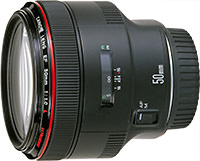
EF50mm f/1.0L USM (Released in 1989)
Weighing 985 g with a construction of 11 lenses in 9 groups, the lens has a closest focusing distance of 60 cm and a filter size of 72 mm. It was the standard lens with the largest aperture diameter in the world at the time it was released.
When the debate to switch to an EF mount first started, optics designers argued strongly for a lens diameter that was capable of achieving f/1.0. The EF mount has a flange back distance of 44 mm and a mount diameter of 54 mm, which made it capable of achieving 50mm f/1.0.
The advantages of a large aperture diameter are utilized in many different ways, such as for producing images with an extremely shallow depth of field, photographing under low-light conditions, making a bright optical viewfinder possible and reducing diffraction.
—Is it true that the EF mount has not changed at all over the past 30 years?
Murakami The physical terminal contacts remain totally unchanged, but the speed of signal transmission has become much faster. Also, even though the content of the signal flow has evolved over time, full compatibility has not been compromised.
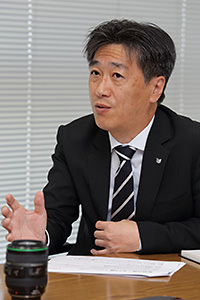
The physical terminal contacts remain unchanged in design and offer full compatibility. (Murakami)
Hayakawa In fact, the content of the signal flow has undergone several changes. This is possible because the entire development process takes place in-house, in conjunction with discussions about the expanded features of cameras and lenses. It would be difficult to expand the features while also ensuring compatibility if development took place in an open environment.
We started off with a single center AF point, and have since then been making constant progress, such as additional AF points, predictive AF for moving bodies and high-speed AF. The speed of communication and computation has also increased by leaps and bounds, so much so that we’ve lost track of how many times faster it is now compared to before. To support such advancements, the fully-electronic EF mount was indispensable. This, I believe, is the definition of innovation.
Shiomi To date, we have continued to review the system with an eye on the future. When the number of AF points is increased, a much faster communication speed becomes necessary. At the same time, there’s been a vast increase in the amount of data contained in the optical information transmitted from the lens to the camera. To be frank, I cannot guarantee that the mode of communication will not change at all in the future. In the past, we considered trying to achieve super high-speed communication via optical communication, but a major issue that we encountered was figuring out how to maintain the compatibility of the system. In the case of the EOS system, it’s crucial to consider how new features can be incorporated while we continue to inherit the existing system.
Suda During the era of the EOS 650, no one would have expected that there would come a day when cameras could be used to shoot movies. The EOS system is an excellent example that demonstrates how advancements can be made while preserving the foundation.
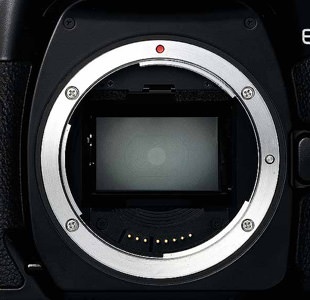
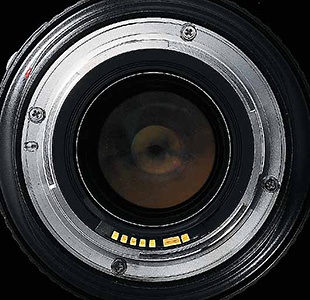
Electronic signals are transmitted between the terminal contacts on the camera (left) and the lens (right). Instead of merely eliminating the mechanical links, the system has evolved while maintaining its compatibility.
